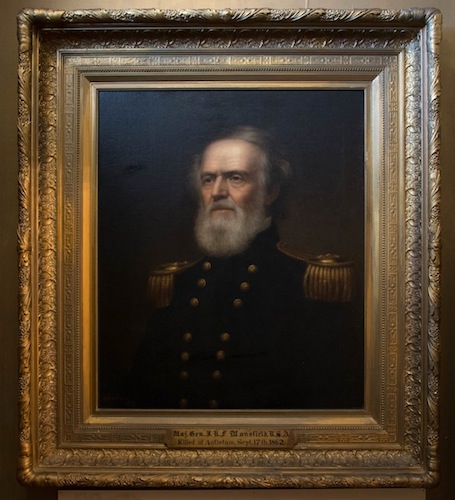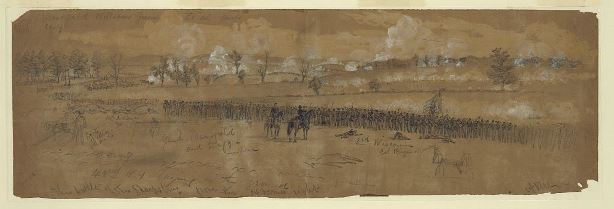By Nancy Finlay
Joseph King Fenno Mansfield was born in New Haven on December 22, 1803. He grew up in his grandfather’s house in Middletown, and at 15 earned admission to West Point, where he excelled, graduating second in the Class of 1822. Upon graduation, he received an appointment as second lieutenant of engineers and spent his early years working on fortifications. Beginning in 1831, he took charge of the construction of Fort Pulaski in the Savannah River, at one time working alongside another young West Point graduate, Lieutenant Robert E. Lee.
An Engineer in the War with Mexico

Major General Joseph King Fenno Mansfield – Courtesy of Middlesex County Historical Society
Advancement came slowly in the peacetime army, and it was 1838 before Mansfield received a promotion to captain. That same year, he married Louisa Maria Mather, back home in Middletown, Connecticut. Six years and three children later (a fourth child dying in infancy), Mansfield received a transfer to the Texas coast, where he served as General Zachary Taylor’s chief engineer. He designed the earthworks along the Rio Grande, later known as Fort Brown, that in May 1846 were the site of one of the first battles of the Mexican War. Mansfield received the rank of brevet major for his distinguished service during this action.
Four months later, in September, he was seriously wounded in the Battle of Monterrey, and promoted to brevet lieutenant colonel. He recovered in time to take part in the Battle of Buena Vista in February 1847, where he was brevetted colonel. In addition to Robert E. Lee, Mansfield’s fellow officers during the Mexican War included Ulysses S. Grant, Jefferson Davis, Thomas (“Stonewall”) Jackson, and James Longstreet, among others. Aside from Grant and Mansfield, all of these talented young officers served the Confederacy during the Civil War.
In 1853, Mansfield received an appointment to the post of Inspector General, a job that required him to visit fortifications in all parts of the country, necessitating his being away from home for more than a year at a time. In 1861, at the outbreak of the Civil War, he earned a promotion to brigadier general and took charge of the defenses of Washington.
Mortally Wounded at the Battle of Antietam
In September 1862, as Lee led his Army of Northern Virginia into Union territory hoping to strike a blow capable of bringing a quick end to the war, Mansfield took command of the Twelfth Corps of the Army of the Potomac. Mansfield rushed to join his command in Maryland, arriving just two days before the Battle of Antietam. Early on the morning of September 17, Mansfield’s Twelfth Corps joined Joseph Hooker’s First Corps in an attack on the Confederate left, in the area known as the East Woods. Almost immediately, Mansfield was shot in the chest and carried from the field, mortally wounded. He died the following day. Between 6,300 and 6,500 soldiers were killed or mortally wounded on that day, including six generals—three on each side.

Alfred R. Waud, The Battle of the Sharpsburg from the extreme right, drawing on paper, September 17, 1862 – Library of Congress, Prints and Photographs Division
Mansfield’s body was brought back to Middletown for burial. He was interred in Mortimer Cemetery following a lavish funeral, attended by Governor Buckingham, the Governor’s Foot Guard, Horse Guard, and the Putnam Phalanx. His body was later moved to Indian Hill Cemetery.
Following the war, the G.A.R. post in Middletown was named in Mansfield’s honor. In 1899, the surviving veterans of this post arranged for a granite monument to be erected in memory of General Mansfield on the spot where he fell on the battlefield at Antietam.
Mansfield’s wife, Louisa, lived in the couple’s Middletown home until her death in 1880. The couple’s youngest daughter, Katherine, then lived in the house until 1918. Today, the General Mansfield House, one of the few surviving 19th-century houses on Middletown’s Main Street, is the headquarters of the Middlesex Historical Society.
Nancy Finlay grew up in Manchester, Connecticut. She has a BA from Smith College and an MFA and PhD from Princeton University. From 1998 to 2015, she was Curator of Graphics at the Connecticut Historical Society.









